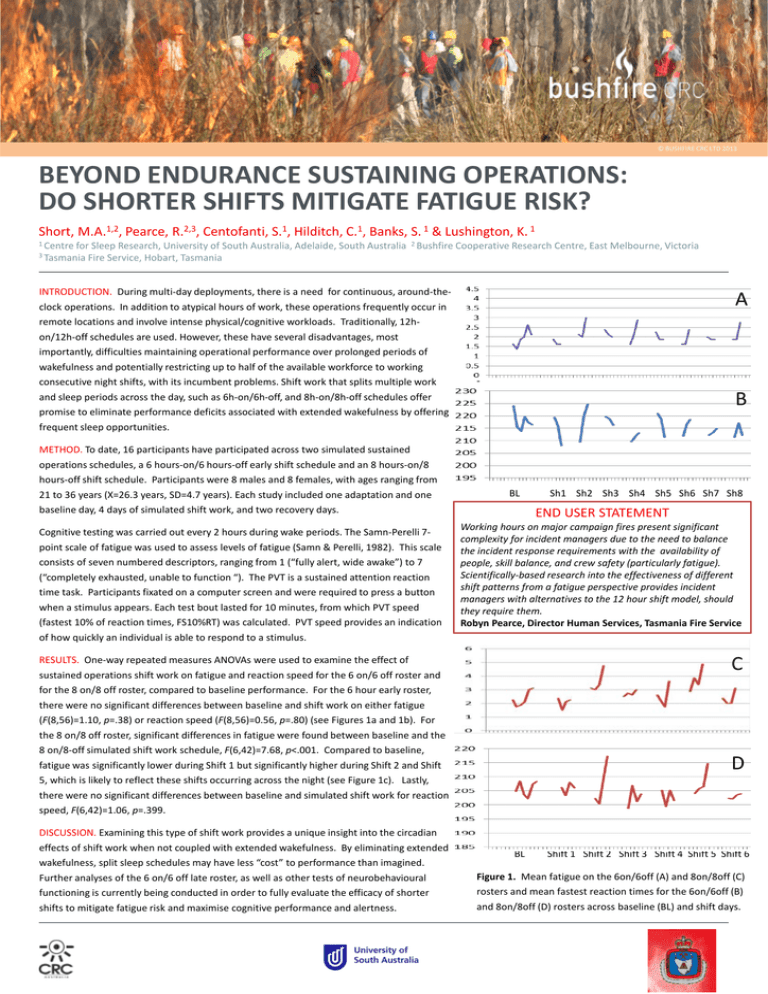Beyond Endurance Sustaining Operations: Do
advertisement

© BUSHFIRE CRC LTD 2013 BEYOND ENDURANCE SUSTAINING OPERATIONS: DO SHORTER SHIFTS MITIGATE FATIGUE RISK? Short, M.A.1,2, Pearce, R.2,3, Centofanti, S.1, Hilditch, C.1, Banks, S. 1 & Lushington, K. 1 1 Centre for Sleep Research, University of South Australia, Adelaide, South Australia 2 Bushfire Cooperative Research Centre, East Melbourne, Victoria 3 Tasmania Fire Service, Hobart, Tasmania INTRODUCTION. During multi-day deployments, there is a need for continuous, around-theclock operations. In addition to atypical hours of work, these operations frequently occur in remote locations and involve intense physical/cognitive workloads. Traditionally, 12hon/12h-off schedules are used. However, these have several disadvantages, most importantly, difficulties maintaining operational performance over prolonged periods of wakefulness and potentially restricting up to half of the available workforce to working consecutive night shifts, with its incumbent problems. Shift work that splits multiple work and sleep periods across the day, such as 6h-on/6h-off, and 8h-on/8h-off schedules offer promise to eliminate performance deficits associated with extended wakefulness by offering frequent sleep opportunities. - METHOD. To date, 16 participants have participated across two simulated sustained operations schedules, a 6 hours-on/6 hours-off early shift schedule and an 8 hours-on/8 hours-off shift schedule. Participants were 8 males and 8 females, with ages ranging from 21 to 36 years (X=26.3 years, SD=4.7 years). Each study included one adaptation and one baseline day, 4 days of simulated shift work, and two recovery days. - Cognitive testing was carried out every 2 hours during wake periods. The Samn-Perelli 7point scale of fatigue was used to assess levels of fatigue (Samn & Perelli, 1982). This scale consists of seven numbered descriptors, ranging from 1 (“fully alert, wide awake”) to 7 (“completely exhausted, unable to function “). The PVT is a sustained attention reaction time task. Participants fixated on a computer screen and were required to press a button when a stimulus appears. Each test bout lasted for 10 minutes, from which PVT speed (fastest 10% of reaction times, FS10%RT) was calculated. PVT speed provides an indication of how quickly an individual is able to respond to a stimulus. RESULTS. One-way repeated measures ANOVAs were used to examine the effect of sustained operations shift work on fatigue and reaction speed for the 6 on/6 off roster and for the 8 on/8 off roster, compared to baseline performance. For the 6 hour early roster, there were no significant differences between baseline and shift work on either fatigue (F(8,56)=1.10, p=.38) or reaction speed (F(8,56)=0.56, p=.80) (see Figures 1a and 1b). For the 8 on/8 off roster, significant differences in fatigue were found between baseline and the 8 on/8-off simulated shift work schedule, F(6,42)=7.68, p<.001. Compared to baseline, fatigue was significantly lower during Shift 1 but significantly higher during Shift 2 and Shift 5, which is likely to reflect these shifts occurring across the night (see Figure 1c). Lastly, there were no significant differences between baseline and simulated shift work for reaction speed, F(6,42)=1.06, p=.399. DISCUSSION. Examining this type of shift work provides a unique insight into the circadian effects of shift work when not coupled with extended wakefulness. By eliminating extended wakefulness, split sleep schedules may have less “cost” to performance than imagined. Further analyses of the 6 on/6 off late roster, as well as other tests of neurobehavioural functioning is currently being conducted in order to fully evaluate the efficacy of shorter shifts to mitigate fatigue risk and maximise cognitive performance and alertness. A - B - BL Sh1 Sh2 Sh3 Sh4 Sh5 Sh6 Sh7 Sh8 END USER STATEMENT Working hours on major campaign fires present significant complexity for incident managers due to the need to balance the incident response requirements with the availability of - skill balance, and crew safety (particularly fatigue). people, Scientifically-based research into the effectiveness of different shift- patterns from a fatigue perspective provides incident managers with alternatives to the 12 hour shift model, should they- require them. Robyn Pearce, Director Human Services, Tasmania Fire Service - C - D BL Shift 1 Shift 2 Shift 3 Shift 4 Shift 5 Shift 6 Figure 1. Mean fatigue on the 6on/6off (A) and 8on/8off (C) rosters and mean fastest reaction times for the 6on/6off (B) and 8on/8off (D) rosters across baseline (BL) and shift days.

